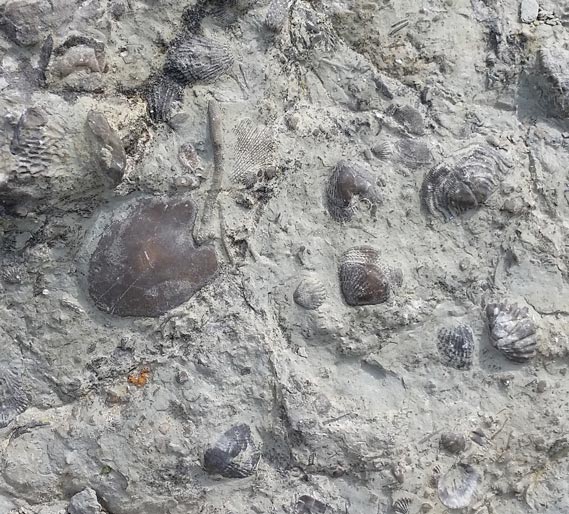New Brachiopod Study Sheds Light on Biodiversity
Research into a living fossil has provided scientists with a fresh perspective on animal evolution. A new brachiopod study, involving the careful analysis of over a thousand genera, indicates these ancient creatures were diversifying and evolving but this did not result in many new species. The research published in the journal “Nature Ecology & Evolution”, challenges some of the core principles of evolution.
Let’s hear it for the humble brachiopod!
What is a Brachiopod?
Brachiopods (Brachiopoda) are shelled animals that originated during the Cambrian. Many resemble Roman oil lamps, hence their common name “lamp-shells”. Their shells consist of two parts (valves), with one part larger than the other. They are entirely marine and benthic. These filter feeders have shells around two to five centimetres in diameter, although some genera grew much larger. Although superficially similar to molluscs such as clams, mussels and oysters, they are not closely related.
Picture credit: Zhen Guo
In many species of brachiopod, the animal is attached to the sea floor by a fleshy stalk (pedicle). The presence of a pedicle is indicated by the hole located on the larger of the valves (see picture above). They were abundant in the Palaeozoic and Mesozoic and are often the most common fossil found in Palaeozoic marine deposits. These ancient creatures are still around today but most species are confined to deep water. Some 12,000 fossil species have been named. In contrast, it has been estimated that there are less than 500 extant species.

Lots of brachiopod and coral fossils to find at Wren’s Nest. The strata were deposited during the Silurian, a time when the Brachiopoda were abundant. Picture credit: Everything Dinosaur.
Picture credit: Everything Dinosaur
New Brachiopod Study
This new brachiopod study is a collaboration between the University of Bristol, the China University of Geosciences and the Open University. The team found that following the end-Permian mass extinction event, the Brachiopoda were evolving in new directions, but this did not lead to many new species. In comparison, the Mollusca became increasingly dominant. Today, the Mollusca is an amazingly diverse phylum with more than 50,000 species. The Brachiopoda currently contains just 394 known species. The research team found that brachiopods were evolving new shell shapes and ecological behaviours following the end-Permian mass extinction, but their diversity did not grow.
Lead author Dr Zhen Guo (China University of Geosciences) explained:
“In the Palaeozoic, from 540 to 250 million years ago, brachiopods ruled the seabed. Most of them are quite small–you could hold twenty of them in your hands; but others were big and thick-shelled and lived a long time. Their shells were anything from circular to widely stretched and they had either smooth shells or carried deep ridges and troughs.”
Professor Michael Benton (University of Bristol), a co-author of the new brachiopod study, commented:
“The brachiopods were hit very hard by the end-Permian mass extinction 252 million years ago. The group could have disappeared completely, and indeed from that point, molluscs just became more and more successful. For a long time, it was thought that the brachiopods remained rare because the survivors were stuck in just a few modes of life.”
Studying Over 1,000 Brachiopod Genera
This new research involved the analysis of a vast brachiopod database. More than 1,000 genera were studied. This database was comprised of brachiopods that lived after the Permian. For each genus, the analysts recorded dozens of measurements of the overall shape of the shells, their external sculpture, and internal anatomy. These features were analysed together to provide measurements of overall diversity of shapes for each major brachiopod group at each point in geological time. This measure of “diversity of shape”, is referred to in biology as “disparity”. An understanding of shape innovations and changes over time could then be plotted.
These Mesozoic-Cenozoic brachiopods were adapting to different modes of life, but there were fewer species evolving than expected.

Reconstructions of some Mesozoic-Cenozoic brachiopods, showing adaptations to certain environments. Picture credit: Shunyi Shi.
Picture credit: Shunyi Shi
The co-author from the Open University, Dr Tom Stubbs added:
“In fact, the post-extinction brachiopods were innovating and trying new modes of life. One group, the terebratulids, were diversifying their body shapes and ecological functions from the end of the Permian to the present day, but their diversity did not increase.”
To read about an earlier, related brachiopod study conducted by University of Bristol researchers: Brachiopods and Bivalves (Mollusca) Faunal Turnover Study.
Unexpected Results
Fellow researcher Professor Zhong-Qiang Chen of the China University of Geosciences said:
“This was quite unexpected. Brachiopods were far from failures after the end-Permian extinction. They were evolving in new directions and exploring new modes of life, just as the molluscs were at the same time. But this did not turn into evolutionary success in terms of the numbers of species. Despite their bursts of evolution in form and function, they could not spread widely, and the exact reason remains unclear.”
Modern brachiopods represent the tip of the ecological iceberg for this once immensely abundant phylum. Extant species do not provide scientists with an understanding of their extremely successful lineage, but we don’t know why these marine creatures did not become super-abundant again after the Permian.
Dr Zhen Guo explained the importance of this research. This new brachiopod study suggests that disparity and diversity are effectively decoupled, at least as far as the Brachiopoda after the Permian are concerned.
Dr Zhen Guo concluded:
“It’s important to understand modern biodiversity in terms of the processes that lie behind it.”
Everything Dinosaur acknowledges the assistance of a media release from the University of Bristol in the compilation of this article.
The scientific paper: “Morphological innovation did not drive diversification in Mesozoic–Cenozoic brachiopods” by Zhen Guo, Michael J. Benton, Thomas L. Stubbs, and Zhong-Qiang Chen published in Nature Ecology & Evolution.
The Everything Dinosaur website: Prehistoric Animal Toys.


